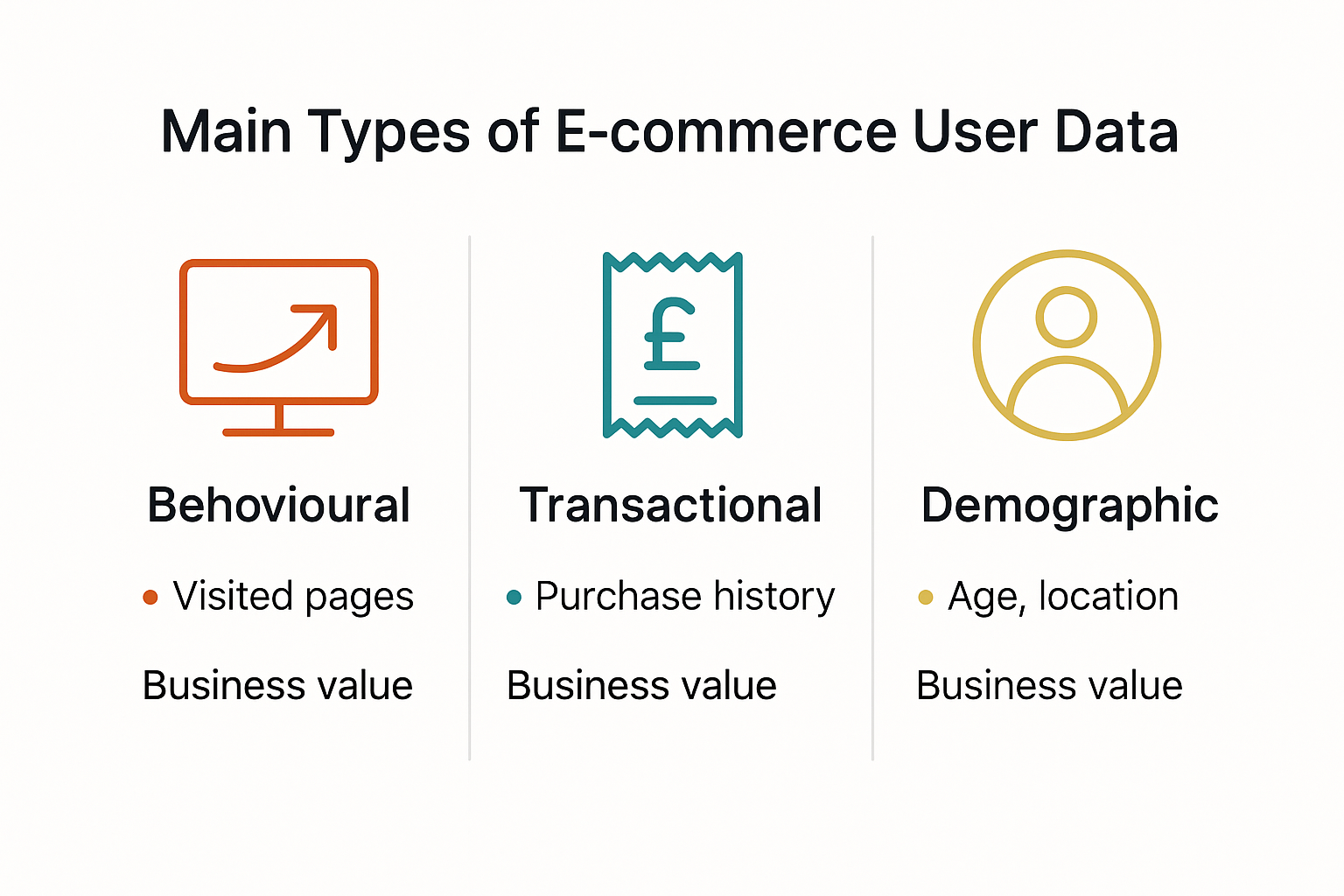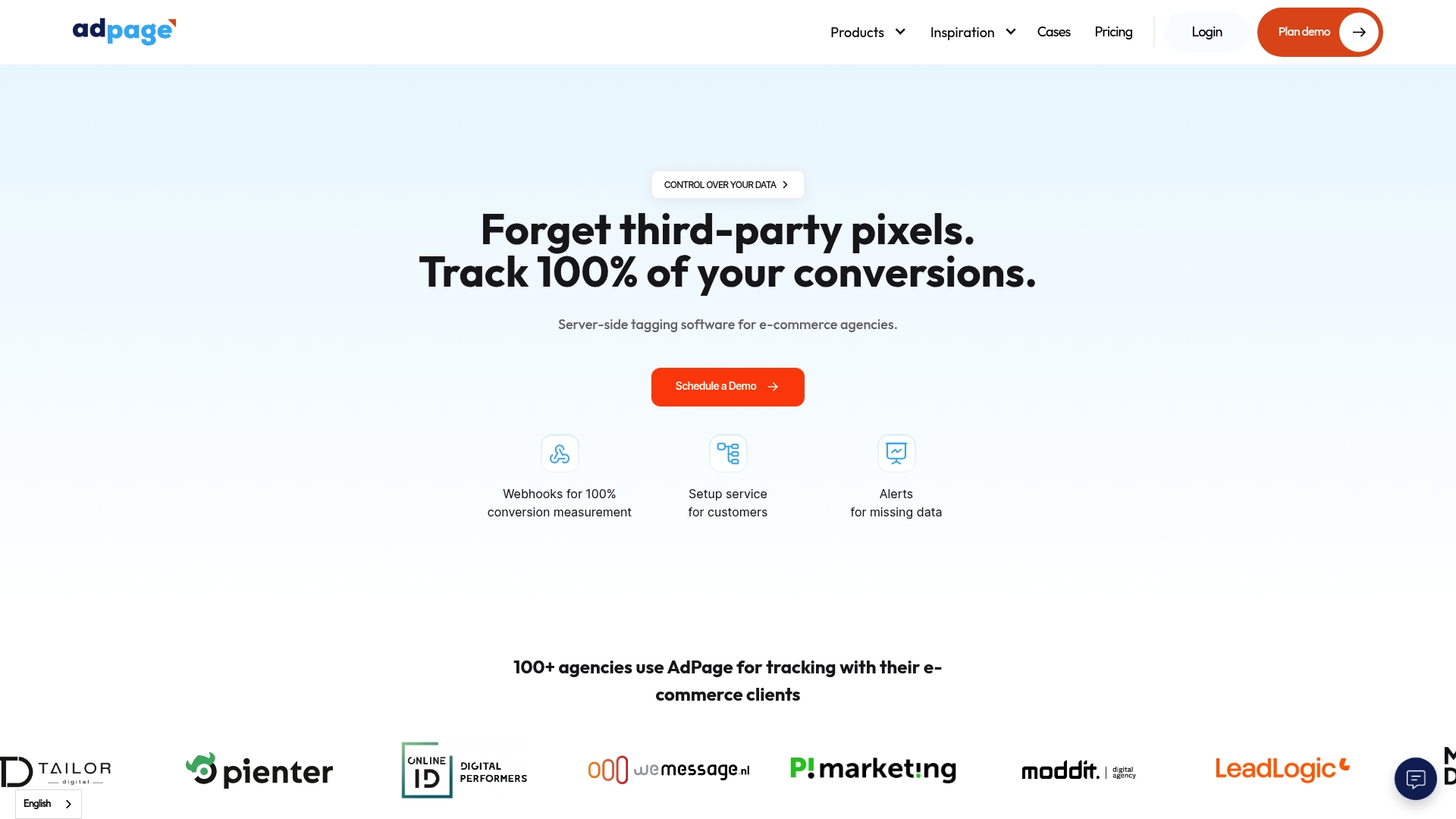Every click, scroll, and purchase on an e-commerce site leaves a trace. Data is piling up faster than ever, with over 500 million user interactions analyzed in a single study revealing more than 10 unique buying patterns. It might sound like a modern gold rush for retailers, but the real surprise is that success in 2025 is not about collecting more data. It is about understanding which data truly matters and how to respect your customer's trust whilst doing it.
Table of Contents
- Key Types Of User Data In E-commerce
- Methods And Tools For Collecting User Data
- Legal And Ethical Considerations In Data Collection.
- Turning User Data Into Actionable Insights
Quick Summary
| Takeaway | Explanation |
|---|---|
| Focus on behavioral data | Analyze customer interactions like clicks and page views to understand preferences. |
| Leverage predictive modeling | Use machine learning to forecast customer purchase behaviors based on historical data patterns. |
| Implement robust consent management | Ensure clear privacy policies and user control over data collection practices. |
| Prioritize ethical data practices | Adhere to data ethics principles like transparency and data minimization for responsible management. |
| Utilize advanced analytics tools | Employ analytics and tracking technologies to gather precise user insights without compromising privacy. |
Key Types of User Data in E-commerce

Understanding user data collection requires a comprehensive approach to capturing and analyzing different categories of digital interactions. E-commerce businesses rely on multiple data types to create personalized experiences and drive strategic decision making.
Here is a summary table outlining the key types of user data in e-commerce, with examples and their main uses:
| Data Type | Examples | Primary Uses |
|---|---|---|
| Behavioural Interaction Data | Page views, clicks, navigation paths, time on site | Understanding preferences, personalization |
| Transactional and Purchase History | Purchase frequency, order value, product categories | Segmentation, predictive modeling |
| Demographic and Personal Profile Info | Age, gender, location, device type, language | Targeted marketing, profile creation |
Behavioural Interaction Data
Behavioural data represents the digital footprints customers leave during their online journey. This includes crucial information such as page views, click patterns, time spent on specific product pages, and navigation pathways. A comprehensive study from the University of California reveals that these interactions provide deep insights into customer preferences and purchase intent.
Specifically, behavioral data can be categorized into two primary segments: anonymous and identified customer interactions. For anonymous sessions, businesses track session-based features like browsing duration, product interactions, and initial engagement metrics. When customers become identified users, the data collection expands to include comprehensive customer history, enabling more nuanced personalization strategies.
Transactional and Purchase History
Transactional data forms the backbone of understanding customer value and purchasing patterns. This category encompasses purchase frequency, average order value, product categories selected, and historical spending trends. By analyzing these metrics, e-commerce platforms can develop sophisticated recommendation engines and targeted marketing strategies.
E-commerce businesses can leverage this data to create predictive models that anticipate future purchasing behavior. The granularity of transactional data allows for segmentation strategies that enable hyper-personalized marketing approaches. Research from the Library of Congress privacy guidelines emphasizes the importance of transparent data usage and customer consent in collecting such detailed information.
Demographic and Personal Profile Information
Demographic data provides critical context to user interactions, including age, gender, location, language preferences, and device types. When combined with behavioral and transactional data, these profiles enable businesses to create highly targeted marketing campaigns and product recommendations.
Advanced data collection strategies go beyond basic demographic information, incorporating sophisticated tracking of user preferences, lifestyle indicators, and potential future needs. This holistic approach transforms raw data into actionable insights that drive conversion rates and enhance customer experience.
Understanding these key types of user data is not just about collection but about creating meaningful, privacy-respecting strategies that genuinely serve customer needs while driving business growth.
Methods and Tools for Collecting User Data.

E-commerce businesses employ sophisticated methods and tools to collect user data, transforming raw digital interactions into actionable insights. Understanding these approaches is crucial for developing effective data collection strategies that balance business intelligence with user privacy.
The following table compares different methods and tools for collecting user data, their examples, purposes, and notable privacy concerns.
| Collection Method/Tool | Examples | Main Purpose | Privacy Considerations |
|---|---|---|---|
| Digital Tracking & Analytics Tools | Server-side tagging, analytics | Track user journeys & behaviors | Can avoid browser cookie issues; risk of over-collection |
| Consent Management & Privacy Tools | Consent pop-ups, privacy policies | User control over data collection | Essential for compliance; transparency required |
| Advanced Methodologies | Machine learning, contextual tracking | Identify patterns, segmentation | Must minimize unnecessary data; avoid excessive cookies |
Digital Tracking and Analytics Tools
Modern e-commerce platforms leverage advanced tracking technologies to capture comprehensive user interactions. According to Harvard Business School Online, businesses can utilise multiple data collection methods including online tracking, transactional systems, and observational techniques.
Analytics tools like server-side tagging enable precise tracking of user journeys without relying solely on browser-based cookies. These sophisticated systems capture detailed user interactions, including page views, product interactions, and conversion paths. By implementing server-side tracking, businesses can mitigate data loss and improve the accuracy of their user behavior analysis.
Consent Management and Privacy Techniques
A 2025 research study investigating user data leakage revealed significant privacy concerns in e-commerce platforms. Approximately 30% of online shops were found to potentially disclose personal information to third parties, highlighting the critical importance of robust consent management strategies.
Effective data collection now requires comprehensive privacy protocols. This includes implementing clear consent mechanisms, providing transparent privacy policies, and ensuring users have control over their personal information. Tools that enable granular consent management allow businesses to collect necessary data while respecting user preferences and regulatory requirements.
Advanced Data Collection Methodologies
Research from a 2024 cybersecurity analysis discovered that 38.5% of examined e-commerce websites deployed over 50 cookies per session, many of which were unnecessary or unclear in function. This underscores the need for more strategic and purposeful data collection approaches.
Advanced methodologies now focus on quality over quantity. Businesses are shifting towards more intelligent data collection techniques that prioritise user experience and data relevance. This includes using machine learning algorithms to identify meaningful interaction patterns, implementing contextual tracking that adapts to user preferences, and developing more nuanced segmentation strategies.
Successful user data collection is no longer about gathering maximum information but about collecting precise, relevant insights that genuinely enhance user experience and drive business growth. The future of e-commerce data strategies lies in balancing technological capability with ethical data practices.
Legal and Ethical Considerations in Data Collection.
E-commerce businesses must navigate a complex landscape of legal and ethical requirements when collecting user data. Understanding and implementing robust data protection strategies is no longer optional but a critical business imperative.
Foundational Data Ethics Principles.
Harvard Business School's data ethics framework outlines five crucial principles that guide responsible data collection: ownership, transparency, privacy, intention, and outcomes. These principles provide a comprehensive approach to managing user information with integrity and respect.
Ownership emphasizes that users fundamentally control their personal data. Transparency requires businesses to clearly communicate how data will be collected, used, and stored. Privacy demands stringent protection mechanisms, while intention focuses on collecting data only for legitimate, well-defined purposes. The outcomes principle ensures that data usage does not inadvertently cause harm or discriminate against users.
Regulatory Compliance and Privacy Frameworks.
The Federal Trade Commission's Fair Information Practice Principles establish critical guidelines for ethical data practices in the digital marketplace. These principles focus on five key areas: notice, choice, access, security, and enforcement.
Notice requires businesses to inform users about data collection practices. Choice gives users control over their data sharing preferences. Access enables users to review and modify their personal information. Security mandates robust protection against unauthorized data breaches. Enforcement ensures accountability through legal and regulatory mechanisms.
Best Practices for Ethical Data Management.
Research published in the journal 'Data' highlights critical best practices for responsible data collection. These include implementing comprehensive data retention policies, practicing data minimization, anonymizing sensitive information, establishing strict access controls, and maintaining robust encryption protocols.
To help summarize the legal and ethical requirements for e-commerce user data collection, the table below outlines key principles, frameworks, and best practices discussed in the article.
| Principle/Framework/Practice | Core Focus / Guideline | Example or Goal |
|---|---|---|
| Data Ethics Principles (HBS). | Ownership, transparency, privacy, intention, outcomes | Users control data, clarity in usage |
| FTC Fair Information Practice | Notice, choice, access, security, enforcement | Inform users, enable control, ensure security |
| Responsible Data Management Practices | Data minimization, anonymization, access controls, encryption | Only necessary data collected, limit access |
Successful e-commerce platforms recognize that ethical data collection is not just a legal requirement but a fundamental trust-building mechanism with customers. By prioritizing user privacy, transparency, and consent, businesses can create more meaningful and respectful digital interactions that foster long-term customer loyalty and brand reputation.
Turning User Data Into Actionable Insights
Transforming raw user data into meaningful business strategies requires sophisticated analytical approaches that go beyond simple data collection. E-commerce businesses must develop advanced techniques to extract valuable insights that drive meaningful decision making and enhance customer experiences.
Predictive Behaviour Modelling
A comprehensive research study examining purchase intent demonstrated remarkable precision in predicting customer behavior by leveraging both anonymous and identified customer session data. The research achieved an impressive F1 score of 96.20% for identified customers, highlighting the potential of advanced analytical techniques.
Predictive behavior modeling involves using machine learning algorithms to analyze historical user interactions, identifying patterns that can forecast future purchasing decisions. By examining factors such as browsing duration, product interactions, and previous purchase history, businesses can develop nuanced predictive models that anticipate customer needs with remarkable accuracy.
Personalization and Targeted Strategies
Research exploring big data-driven strategies reveals how personalized recommendations and targeted marketing significantly enhance consumer satisfaction and sustainable purchasing behavior. These strategies transform user data into tailored experiences that resonate with individual customer preferences.
Effective personalization goes beyond simple product recommendations. It involves creating comprehensive user profiles that capture subtle behavioral nuances, enabling businesses to craft highly contextual marketing approaches. This might include dynamic pricing strategies, personalized communication channels, and precisely timed promotional content that aligns with individual user preferences.
Advanced Data Mining and Machine Learning
A groundbreaking study analyzing user behavior data processed over 500 million user interaction records, revealing more than 10 distinct behavioral patterns. The research demonstrated that deep learning-based prediction models could achieve an 85% accuracy rate in anticipating user purchase intentions.
Advanced data mining techniques allow businesses to uncover hidden insights within complex datasets. Machine learning algorithms can identify non-linear relationships and subtle correlations that traditional analytical methods might overlook. These sophisticated approaches enable businesses to develop more responsive, adaptive strategies that evolve with changing customer behaviors.
The ultimate goal of transforming user data into actionable insights is not merely to collect information but to create a dynamic, responsive ecosystem that anticipates and meets customer needs. By combining technological sophistication with genuine user understanding, e-commerce businesses can develop strategies that are both intelligent and empathetic.
Frequently Asked Questions
What types of user data are collected in e-commerce?
E-commerce businesses typically collect behavioral interaction data, transactional and purchase history, and demographic and personal profile information to enhance customer experiences and inform business strategies.
How do e-commerce businesses ensure ethical data collection?
E-commerce companies ensure ethical data collection by adhering to foundational data ethics principles such as transparency, user consent, data minimization, and by complying with regulatory frameworks like the GDPR.
What tools are available for collecting user data in e-commerce?
Common tools include digital tracking and analytics platforms, consent management software, and advanced methodologies like machine learning algorithms that help identify meaningful patterns in user interactions.
How can user data be turned into actionable insights?
User data can be transformed into actionable insights through techniques such as predictive behavior modeling, personalization strategies, and advanced data mining, allowing businesses to anticipate customer needs and improve engagement.
Transform User Data Collection Into Real Growth for Your Online Store
Struggling to make sense of your e-commerce user data? In a world where every click and conversion counts, the biggest challenge today lies in collecting the right data accurately. As explored in this article, the shift toward behavioral analysis, robust consent management, and predictive modeling highlights the pain of fragmented tracking and potential data loss. If your current analytics setup is missing conversions or failing to keep pace with privacy demands, it is time for a smarter, compliant approach.

Stop letting valuable conversions slip away. Discover how AdPage's server-side tagging and consent management tools ensure you monitor 100% of your conversions and protect user trust, whether working with Shopify, WooCommerce, or Magento. Take control of reliable user data now. Visit AdPage to unlock complete tracking, granular reporting, and seamless integration for your business success in 2025.



.png)
